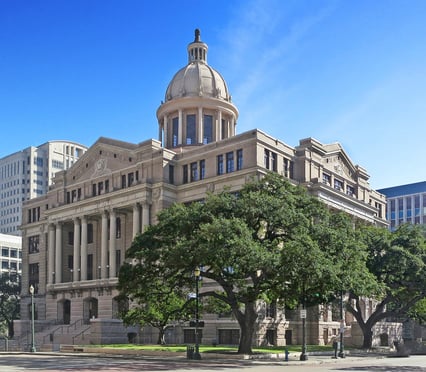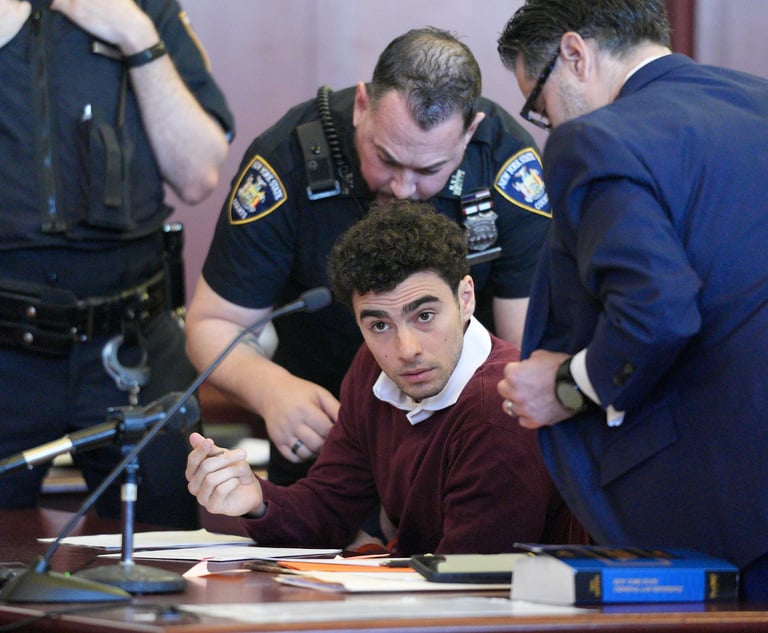Texas Supreme Court Ditches Long-Standing Precedent to Hold Conspiracy Is a Derivative Claim Governed by the Statute of Limitations for the Underlying Tort
In "Agar," the Texas Supreme Court conclusively established how limitations will operate with respect to civil conspiracy claims, and in the process rejected decades of precedent on the subject from the state's intermediate courts of appeals.
April 10, 2019 at 11:13 AM
5 minute read
 Texas Supreme Court. Credit: i_am_jim via Wikimedia Commons
Texas Supreme Court. Credit: i_am_jim via Wikimedia Commons
Dirty Harry Callahan once warned, “A man's got to know his limitations.” Last Friday, the Supreme Court of Texas helped us out on that front.
In Agar v. Electro Circuits Int'l, No. 17-0630, 2019 WL 1495211 (Tex., April 5, 2019), the Supreme Court of Texas conclusively established how limitations will operate with respect to civil conspiracy claims here in Texas, and in the process rejected decades of precedent on the subject from the state's intermediate courts of appeals.
In a unanimous opinion written by Justice John Devine (with newly minted Justice Brett Busby not taking part), the court held that “civil conspiracy is a derivative claim that takes the limitations period of the underlying tort that is the object of the conspiracy,” rather than being governed by a fixed statute of limitations.
The court first resolved a threshold issue on which it acknowledged prior case law (including decisions from the Supreme Court, itself) had left “Texas's position … arguably unclear.” It confirmed that “civil conspiracy is a theory of vicarious liability and not an independent tort.” Then, “[h]aving determined that civil conspiracy is not an independent tort,” the court explained, “it follows that the claim does not have its own statute of limitations.” Instead, “a civil conspiracy claim is connected to the underlying tort and survives or fails alongside it.”
The ruling brings Texas in line with the majority of other jurisdictions throughout the country that have considered the question. The court noted that the highest courts in four other states had held civil conspiracy to be “a theory of derivative liability that shares a limitations period with that of its underlying tort.” And it observed that the intermediate courts of appeals of at least six other states, including New York, California, and Illinois, had done so as well.
But reaching this conclusion required the Supreme Court to disapprove the decisions of every Texas intermediate court of appeals to have addressed the issue. All 12, the court said, had held a conspiracy to be governed by the two-year statute of limitations in Texas Civil Practice & Remedies Code §16.003, applicable to most torts in Texas.
Invoking the previously unbroken chain of Texas intermediate appeals court precedent, Electro Circuits International protested that the court “should not overturn the court of appeals' decades-long uniform application of the two-year limitations period to civil conspiracy.”
But the Supreme Court made clear it was not constrained by those prior decisions, observing that “a long history of mistaken application alone is insufficient to counsel against correcting the error.” Nor, the court said, was the Legislature's failure to clarify or amend the statutes of limitations in the face of that prior precedent to be taken as “evidence that those decisions are in line with the statutory scheme.”
The Supreme Court also went on to hold that a conspiracy claim accrues, and the limitations period begins to run, along with the underlying tort. It rejected a separate “last overt act” accrual rule for conspiracy.
On the issue of accrual—unlike the main issue regarding which limitations period applies to conspiracy—the court observed that the law in other jurisdictions is not entirely uniform, with some states having adopted the rule that a claim for conspiracy “does not accrue until the last overt act of the conspiracy.” But the somewhat limited precedent in Texas aligned with those jurisdictions that “treat[ed] each underlying tort of the conspiracy as having its own limitations which runs from the time the act is committed” and the resulting injury occurs, and the Supreme Court agreed with that approach.
The court explained that, where a claimant alleges a conspiracy to commit multiple torts, this can lead to a somewhat odd result: with the conspiracy claim accruing and limitations running separately with respect to each underlying tort, there may be multiple potential points of accrual and therefore different limitations deadlines for such a single, but multifaceted, conspiracy claim.
In its ruling on the case, the Houston Fourteenth Court of Appeals had stayed the course uniformly established by Texas precedent to that point (including its own prior decision in Mayes v. Stewart, 11 S.W.3d 440 (Tex. App. – Houston [14th Dist.] 2000, pet. denied), holding conspiracy to be governed by the two-year statute of limitations in §16.003.
But when the court of appeals denied rehearing en banc, Chief Justice Kem Thompson Frost issued a concurring opinion in which she explained at some length why the vicarious- or derivative-liability theory of conspiracy limitations is the “better” and “sounder” rule.
Chief Justice Frost declined to dissent from the denial of en banc review at the appeals-court level, concerned about creating a rift with the First Court of Appeals with which her court shares jurisdiction. But she used her concurrence to urge the Supreme Court of Texas to “clarify the law in this murky area and announce this new rule for applying the statute of limitations to civil conspiracy” in Texas, i.e., the rule the Supreme Court pronounced in Agar, thereby establishing that “sounder rule” as the uniform standard to be applied throughout the state.
Ken Carroll heads the appellate practice group at Carrington Coleman Sloman & Blumenthal.
This content has been archived. It is available through our partners, LexisNexis® and Bloomberg Law.
To view this content, please continue to their sites.
Not a Lexis Subscriber?
Subscribe Now
Not a Bloomberg Law Subscriber?
Subscribe Now
NOT FOR REPRINT
© 2025 ALM Global, LLC, All Rights Reserved. Request academic re-use from www.copyright.com. All other uses, submit a request to [email protected]. For more information visit Asset & Logo Licensing.
You Might Like
View All

Nondisparagement Clauses in Divorce: Balancing Family Harmony and Free Speech
6 minute read

Trending Stories
- 1Bribery Case Against Former Lt. Gov. Brian Benjamin Is Dropped
- 2‘Extremely Disturbing’: AI Firms Face Class Action by ‘Taskers’ Exposed to Traumatic Content
- 3State Appeals Court Revives BraunHagey Lawsuit Alleging $4.2M Unlawful Wire to China
- 4Invoking Trump, AG Bonta Reminds Lawyers of Duties to Noncitizens in Plea Dealing
- 522-Count Indictment Is Just the Start of SCOTUSBlog Atty's Legal Problems, Experts Say
Who Got The Work
J. Brugh Lower of Gibbons has entered an appearance for industrial equipment supplier Devco Corporation in a pending trademark infringement lawsuit. The suit, accusing the defendant of selling knock-off Graco products, was filed Dec. 18 in New Jersey District Court by Rivkin Radler on behalf of Graco Inc. and Graco Minnesota. The case, assigned to U.S. District Judge Zahid N. Quraishi, is 3:24-cv-11294, Graco Inc. et al v. Devco Corporation.
Who Got The Work
Rebecca Maller-Stein and Kent A. Yalowitz of Arnold & Porter Kaye Scholer have entered their appearances for Hanaco Venture Capital and its executives, Lior Prosor and David Frankel, in a pending securities lawsuit. The action, filed on Dec. 24 in New York Southern District Court by Zell, Aron & Co. on behalf of Goldeneye Advisors, accuses the defendants of negligently and fraudulently managing the plaintiff's $1 million investment. The case, assigned to U.S. District Judge Vernon S. Broderick, is 1:24-cv-09918, Goldeneye Advisors, LLC v. Hanaco Venture Capital, Ltd. et al.
Who Got The Work
Attorneys from A&O Shearman has stepped in as defense counsel for Toronto-Dominion Bank and other defendants in a pending securities class action. The suit, filed Dec. 11 in New York Southern District Court by Bleichmar Fonti & Auld, accuses the defendants of concealing the bank's 'pervasive' deficiencies in regards to its compliance with the Bank Secrecy Act and the quality of its anti-money laundering controls. The case, assigned to U.S. District Judge Arun Subramanian, is 1:24-cv-09445, Gonzalez v. The Toronto-Dominion Bank et al.
Who Got The Work
Crown Castle International, a Pennsylvania company providing shared communications infrastructure, has turned to Luke D. Wolf of Gordon Rees Scully Mansukhani to fend off a pending breach-of-contract lawsuit. The court action, filed Nov. 25 in Michigan Eastern District Court by Hooper Hathaway PC on behalf of The Town Residences LLC, accuses Crown Castle of failing to transfer approximately $30,000 in utility payments from T-Mobile in breach of a roof-top lease and assignment agreement. The case, assigned to U.S. District Judge Susan K. Declercq, is 2:24-cv-13131, The Town Residences LLC v. T-Mobile US, Inc. et al.
Who Got The Work
Wilfred P. Coronato and Daniel M. Schwartz of McCarter & English have stepped in as defense counsel to Electrolux Home Products Inc. in a pending product liability lawsuit. The court action, filed Nov. 26 in New York Eastern District Court by Poulos Lopiccolo PC and Nagel Rice LLP on behalf of David Stern, alleges that the defendant's refrigerators’ drawers and shelving repeatedly break and fall apart within months after purchase. The case, assigned to U.S. District Judge Joan M. Azrack, is 2:24-cv-08204, Stern v. Electrolux Home Products, Inc.
Featured Firms
Law Offices of Gary Martin Hays & Associates, P.C.
(470) 294-1674
Law Offices of Mark E. Salomone
(857) 444-6468
Smith & Hassler
(713) 739-1250






